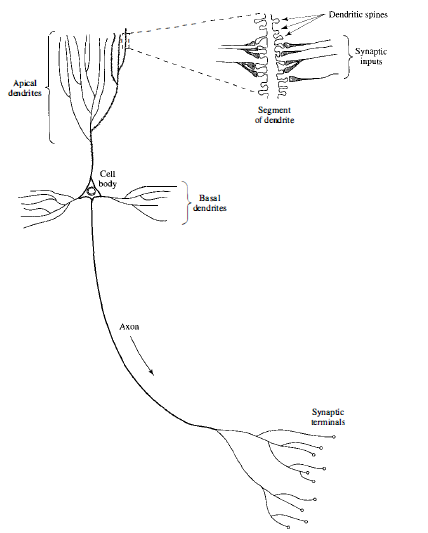Human Brain
Introduction: -The human nervous system may be viewed as a three-stage system, as depicted in the block diagram. Central to the system is the brain, represented by the neural (nerve) net, which continually receives information, perceives it, and makes appropriate decisions. Those pointing from left to right indicate the forward transmission of information-bearing signals through the system. The arrows pointing from right to left signify the presence of feedback in the system. The receptors convert stimuli from the human body or the external environment into electrical impulses that convey information to the neural net (brain).The effectors convert electrical impulses generated by the neural net into discernible responses as system outputs.
 Synapses are elementary structural and functional units that mediate the interactions between neurons. The most common kind of synapse is a chemical synapse, which operates as follows. A presynaptic process liberates a transmitter substance that diffuses across the synaptic junction between neurons and then acts on a postsynaptic process. Thus a synapse converts a presynaptic electrical signal into a chemical signal and then back into postsynaptic electrical signal. In traditional descriptions of neural organization, it is assumed that a synapse is a simple connection that can impose excitation or inhibition, but not both on the receptive neuron.
Synapses are elementary structural and functional units that mediate the interactions between neurons. The most common kind of synapse is a chemical synapse, which operates as follows. A presynaptic process liberates a transmitter substance that diffuses across the synaptic junction between neurons and then acts on a postsynaptic process. Thus a synapse converts a presynaptic electrical signal into a chemical signal and then back into postsynaptic electrical signal. In traditional descriptions of neural organization, it is assumed that a synapse is a simple connection that can impose excitation or inhibition, but not both on the receptive neuron.
Axons, the transmission lines, and dendrites, the receptive zones, constitute two types of cell filaments that are distinguished on morphological grounds; an axon has a smoother surface, fewer branches, and greater length, whereas a dendrite has an irregular surface and more branches.
Neurons come in a wide variety of shapes and sizes in different parts of the brain. A pyramidal cell, which is one of the most common types of cortical neurons. Like many other types of neurons, it receives most of its inputs through dendritic spines. The pyramidal cell can receive 10,000 or more synaptic contacts and it can project onto thousands of target cells.
The majority of neurons encode their outputs as a series of brief voltage pulses. These pulses, commonly known as action potentials or spikes, originate at or close to the cell body of neurons and then propagate across the individual neurons at constant velocity and amplitude. The reasons for the use of action potentials for communication among neurons are based on the physics of axons. The axon of a neuron is very long and thin and is characterized by high electrical resistance and very large capacitance.